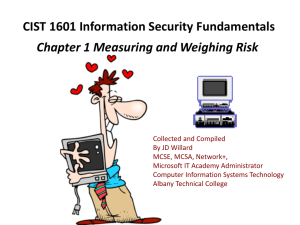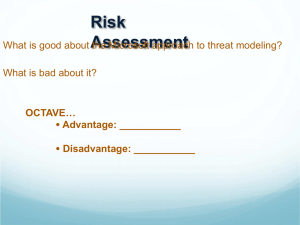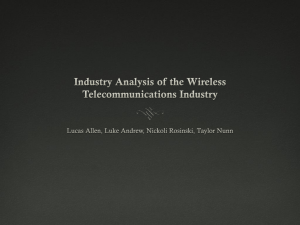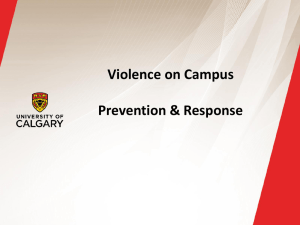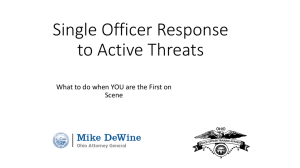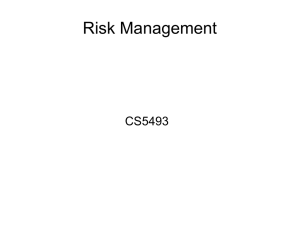product_spotlight-what_would_an_attacker_do
advertisement
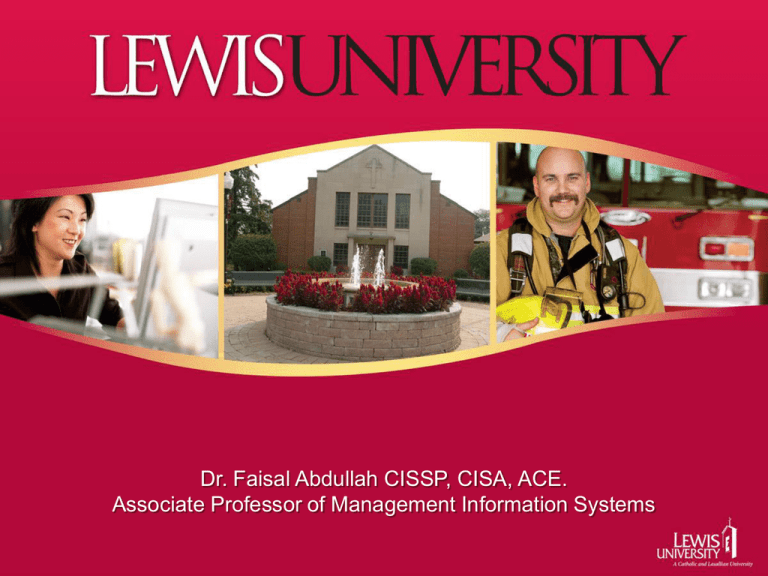
Dr. Faisal Abdullah CISSP, CISA, ACE. Associate Professor of Management Information Systems Dr. Faisal Abdullah • Director of the Master of Science in Information Security Program (MSIS) • Associate Professor of MIS • Research and Teaching Interests include: – Information Security Risk Analysis – Computer Forensics – Management of Information Security Lewis University • • • Founded in 1932 on 376 acre campus in Romeoville, IL Offers 80 undergraduate and 25 graduate programs to approximately 6,500 students Guided by its Catholic and Lasallian heritage • Nationally recognized by • Lewis is playing the University of Southern California in NCAA National Collegiate Men’s Volleyball Championship at 8pm PST this evening MSIS • MSIS Program – This online degree program explores the theory and practice of IT security on a global scale, the latest advances in all of the involved technologies, as well as legal and ethical levels facing IT security professionals. – Outcomes map to eleven certifications including CISSP, CISM, CEH, CRISC – 2 concentrations: Managerial and Technical – To learn more, visit online.lewisu.edu or call 1-866967-7046 Technology and Non-Profit Organization • Connectivity and Internet presence is vital to any organization • Non-profit organizations use information technology to – disseminate information – raise funds – manage resources. Information Security and Non-profits • Most non-profits mainly focus their strategies on – fundraising – operations, • Not on information security and data protection. Information Security and Non-profits • Non-profit organizations face the same information security threats as any other organization • But do not do not have the same resources available to for-profit companies • According to the FBI non-profit organizations are most susceptible to security incidents Data Assets of a Non-profit organization • Donor records – personal information – Addresses – phone numbers • Donor credit card details • Donor bank information • Organizational data Data Assets of a Healthcare Non-profit organization • confidential patient information – Patient names, – Patient addresses, – Medical history – Family information RISKS OF LOSSES TO NON-PROFIT ORGANIZATIONS • • • • • Financial Loss Loss of Reputation Damaged Employee Morale and Defections Donor Disenchantment and Loss Litigation How to protect your organization? • Information security is a technical business discipline. • Protect your organization by mitigating Risks • Use qualitative and quantitative techniques for risk assessment What is Risk Management? • Process of identifying and controlling risks facing an organization • Involves identifying organization’s assets and identifying threats/vulnerabilities • Know yourself and know the enemy • Management buy-in crucial for Risk Management. Topdown approach Risk Management • • • • • Step 1 Identify Assets Step 2 Identify Value of Assets Step 3 Identify Vulnerabilities of Assets Step 4 Threat Identification Step 5 Assess the exposure of the asset to a particular Threat Risk Management • Step 6 Calculate the loss from a single incident • Step 7 Assess the likelihood of occurrence for each Threat • Step 8 Calculate the losses per year from each threat • Step 9 Indentify Controls • Step 10 Constant evaluation and maintenance Risk Management Step 1 – Identify Assets • Inventory of all Data and Information Assets • IT Department may have a list of all IT Assets Risk Management Step 1 – Identify Assets • Determine location of the Data Assets – Donor information – Credit card and financial information – Campaign plans – Employee data – Healthcare data – Anything valuable to the organization Risk Management: Step 2 Value of Tangible Assets • Calculate the Asset value (AV) – Tangible and Intangible • For Tangible Assets consider – Purchase cost – Installation cost – Troubleshooting cost – Contingencies – Loss of business services to outside customers – Loss of business services to internal employees Ding Tan, 2002. Risk Management: Step 2 Value of Intangible Assets • For Intangible Assets – goodwill, reputation – Income Approach • Economic Benefit of an Asset – Consider Cost of Litigation Ding Tan, 2002. Risk Management Step 3 Identify Vulnerabilities of Assets • Identify Logical and Physical vulnerabilities • Conduct a vulnerability assessment and a penetration test • For an independent evaluation • Hire an independent firm or outside consultant Risk Management Step 4 Threat Identification • Realistic threats • Identify threats based on Vulnerabilities identified in Step 3 Risk Management Step 4 Threat Identification • Sources of internal data • IT Help Desk • Users • Managers and Supervisors • Human Resourses Department Risk Management Step 4 Threat Identification • Sources of external data – Threat advisories – Industry and peer reports – Insurance reports – Government reports – National Weather Bureau Risk Management Step 5 Exposure of an Asset • Evaluate robustness of existing controls – Exposure Factor (EF) Ding Tan, 2002. Risk Management Step 5 Exposure of an Asset Start with 100% for the starting exposure factor and answer each of the following questions 1. Does the system under attack have any redundancies/ backups/ copies ? Subtract 30% if the answer is YES. 2. Is the system under attack behind a firewall? Subtract 10% if the answer is YES 3. Is the attack from outside ? Subtract 20% if the answer is YES 4. What is the potential rate of attack? (10% damage / hour vs. 10% damage / min) Subtract 20% if the answer is less than 20% damage/hr Subtract 40% if the answer is less than 2% damage/hr 5. What is the likelihood that the attack will go undetected in time for a full recovery? Subtract 10% if the probability of being undetected is less than 20% Subtract 30% if the probability of being undetected is less than 10% 6. How soon can countermeasures be implemented in time if at all? Subtract 30% if the countermeasure can be implemented within ½ hour Subtract 20% if the countermeasure can be implemented within 1 hour Subtract 10% if the countermeasure can be implemented within 2 hours Risk Assessment Step 6 Loss from an incident • Calculate the loss from a one time occurrence of a threat • Single Loss Expectancy (SLE) = Asset Value (AV) X Exposure Factor (EF) Ding Tan, 2002. Risk Assessment: Step 7 Likelihood of Occurrence • Assess the likelihood of occurrence for each threat during a period of one year. – Annual Rate of occurrence (ARO) Risk Assessment: Step 7 Likelihood of Occurrence • Assess ARO from internal resources • IT Help Desk • Users • Managers and Supervisors • Human Recourses Department Risk Assessment: Step 7 Likelihood of Occurrence • Assess ARO from External resources – Threat advisories – Industry and peer reports – Insurance reports – Government reports – National Weather Bureau data Risk Management – Step 8 Loss per year • Calculate the Annual Loss Expectancy (ALE) – Losses per year from each threat • Annual Loss Expectancy (ALE) = Single Loss Expectancy (SLE) x Annual Rate of Occurrence (ARO) Ding Tan, 2002. Risk Assessment Example Vulnerability: Unsecured Data server Threat: Loss of proprietary software - outsider attack EF Calculations back Up copies: NO System behind Firewall: NO Attack from outside: YES Potential Rate of Attack: less than 20% damage/hour Likelihood attack will be undetected: less than 20% Countermeasures: Implemented within 2 hours EF = Asset Value (Value of the proprietary software) SLE = Asset Value * EF SLE ALE = SLE * ARO ARO ALE Ding Tan, 2002. Less 100% 0% Less 20% Less 20% Less less 10% 10% 40% 100000 40000 2 80000 Risk Management Step 9 Identify Controls • Indentify Controls based on the Risk from each threat • Mitigate risks to an acceptable level by applying controls Risk Management Step 9 Identify Controls • Controls can be – Good Policies – Security Awareness – Employee and user training – Software Controls – Hardware Controls – Personnel Controls Risk Management Step 9 Identify Controls • Cost-Benefit Analysis – Cost of implementing a control – Benefit – reduction in losses from a threat Risk Management Step 10 constant evaluation of controls • Test and implement controls • Periodic evaluation to assess efficacy of controls

